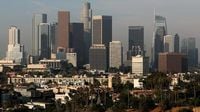Los Angeles, once the undisputed capital of film and television production, has hit another sobering milestone: production activity in the region has dropped to its lowest point in recent memory. According to multiple reports released this week—including from FilmLA, the city and county’s film permitting office—on-location production in Los Angeles declined by 13.2% during the third quarter of 2025 compared to the same period last year. The total number of shoot days across feature films, television, commercials, and other projects tallied just 4,380 from July through September, marking a new nadir for the city’s creative industry.
The steep decline comes as no surprise to industry observers who have watched the region’s fortunes wane since the record-breaking highs of 2021, during the peak of the streaming wars. The dual Hollywood writers’ and actors’ strikes of 2023 hastened an exodus of projects, compounding the effects of rising labor costs, oversubscription to California’s tax credit program, and the allure of more generous subsidies elsewhere. As The Hollywood Reporter noted, “Production in the region has been slipping since the record highs of 2021. Since then, the dual writers and actors strikes hastened the exodus of films and TV shows out of L.A.”
In a city built on dreams and drama, the numbers themselves tell a dramatic story. Feature film production provided a rare bright spot, increasing by 9.7% year-over-year to 522 shoot days in Q3 2025, according to FilmLA. This uptick, though, is tempered by the fact that it still sits 30% below the five-year average, as reported by Variety. Much of the increase is attributed to independent projects, as big-budget studio films continue to migrate to other states and countries with more enticing incentives. Out of 48 titles that received filming subsidies earlier this year, only five were feature films, reflecting a shift by the California Film Commission toward supporting indie productions.
Television, long the anchor of Los Angeles production, has been hardest hit. TV production fell 20.7% year-over-year in Q3 2025, totaling 1,441 shoot days. The main culprit? A precipitous drop in reality TV, which saw its second-worst quarter in 15 years. Reality TV shoot days plummeted by 42% compared to the previous quarter, landing at just 649—a staggering 67% below the five-year average, according to The Hollywood Reporter and Variety. Shows like Dancing With the Stars (ABC), The Price Is Right (CBS), The Valley (Bravo), Dinner Time Live With David Chang (Netflix), and The Secret Lives of Mormon Wives (Hulu) are among the few reality titles still filming in the region. Other TV genres didn’t fare much better: TV dramas dropped 19% to 545 shoot days, while comedy actually rose 41%—but only to a modest 79 shoot days. TV pilot production was also down sharply, dropping 34.5% to just 19 shoot days in the third quarter.
“We know that it will take a little while for new incentive-backed projects to get underway and be reflected in our data, so we were not surprised to see on-location production continue to slip this summer despite the state’s increased investment,” said Philip Sokoloski, FilmLA’s Vice President, in a statement quoted by multiple outlets. “Fortunately, we’ve already begun to see early signs of these incentives having their desired effect; we’re excited to be taking calls from productions looking to line up their locations and pull permits.”
The state of California is betting big on a turnaround. Earlier this year, lawmakers dramatically expanded the film and TV tax credit program, boosting the annual subsidy from $330 million to $750 million and expanding eligibility to include sitcoms, animation, and large-scale competition shows (though game shows, talk shows, and commercials remain excluded). Productions can now receive up to 40% of eligible costs, and the expansion is expected to funnel as much as $3.75 billion in credits to the industry over the next five years. The first projects approved under the revamped program were announced in August, including 18 television series planned for the greater Los Angeles area, as well as high-profile titles like Apple TV+’s The Studio and a new HBO series from Larry David. However, there’s a catch: each project has 180 days to begin production after receiving the incentive, so the impact of this massive investment may not be visible in the data until well into 2026.
But not everyone is convinced that the expanded incentives will be the silver bullet the industry needs. Skeptics argue that some productions would have shot in California even without the tax credits, meaning the state could end up subsidizing projects that were already likely to stay. The coming six months are widely seen as a crucial test—will the new incentives attract fresh productions, or will they merely maintain the status quo?
The challenge facing Los Angeles is not unique. Production has declined globally since the post-pandemic frenzy of 2022, with significant drops reported in Georgia, New York, Canada, and the U.K., according to Variety. The U.K., in particular, has become a magnet for big-budget studio films, thanks to its policy of allowing above-the-line costs (such as pay for directors and actors) to qualify for subsidies. Meanwhile, Los Angeles continues to grapple with higher labor costs and intense competition from other regions.
Despite the gloomy numbers, some in the industry remain cautiously optimistic. FilmLA is actively working to streamline and enhance the on-location filmmaking process, convening industry listening sessions and recommending policy improvements to local government partners. “L.A.’s creative industry is too important to let go without a fight,” Sokoloski told The Hollywood Reporter. “As part of our ongoing focus on streamlining and enhancing the on-location filmmaking process, we are convening industry listening sessions and using what we learn to improve our service delivery and recommend actionable process and policy improvements to our valued government partners.”
There are even hints of a broader recovery on the horizon. According to production tracking service ProdPro, global filming activity has actually increased by 11% compared to the same period last year, suggesting that Los Angeles’ woes are not universal—and that the city could rebound if local conditions improve.
For now, though, the city’s film and TV professionals are left waiting and hoping. The next six months will be pivotal, as the effects of California’s expanded tax credits begin to ripple through the industry. Will Los Angeles reclaim its status as the world’s entertainment capital, or will it continue to cede ground to rivals both at home and abroad? The answer, as always in Hollywood, remains to be seen.






